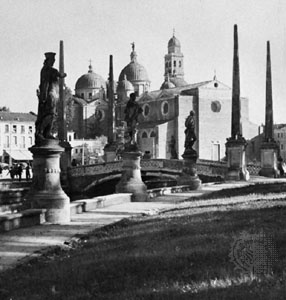Padua
Italy
Italian Padova, Latin Patavium,
 city, Veneto region, northern Italy, on the River Bacchiglione, west of Venice. The Roman Patavium, founded, according to legend, by the Trojan hero Antenor, it was first mentioned in 302 BC, according to the Roman historian Livy, who was born there (59 BC). The town prospered greatly and, in the 11th–13th century, was a leading Italian commune. The poet Dante lived there, and St. Anthony of Padua is buried there. It was governed by the Carrara family from 1318 to 1405, when it passed to Venice, which held it until 1797. Under Austrian dominion from 1815 to 1866, it was active in the Risorgimento (movement for Italian independence); a rising took place there in February 1848. It was heavily bombed in World War II, and the frescoes by Andrea Mantegna in the Church of the Eremitani were almost completely destroyed.
city, Veneto region, northern Italy, on the River Bacchiglione, west of Venice. The Roman Patavium, founded, according to legend, by the Trojan hero Antenor, it was first mentioned in 302 BC, according to the Roman historian Livy, who was born there (59 BC). The town prospered greatly and, in the 11th–13th century, was a leading Italian commune. The poet Dante lived there, and St. Anthony of Padua is buried there. It was governed by the Carrara family from 1318 to 1405, when it passed to Venice, which held it until 1797. Under Austrian dominion from 1815 to 1866, it was active in the Risorgimento (movement for Italian independence); a rising took place there in February 1848. It was heavily bombed in World War II, and the frescoes by Andrea Mantegna in the Church of the Eremitani were almost completely destroyed.The Scrovegni Chapel (1303–05) contains famous frescoes by Giotto, and the Scuola del Santo (“School of the Saints,” a medieval trade-guild building) has frescoes by Titian. The cathedral (rebuilt 1552) has a Romanesque baptistery. The Basilica of San Antonio (1232–1307) contains the tomb of the saint and has statues and reliefs by Donatello on the high altar. In the piazza before the basilica is Donatello's magnificent equestrian bronze statue (set up in 1453) of the Venetian condottiere Erasmo da Narni (called Gattamelata). Other notable secular landmarks include the Ragione Palazzo (1218–19; rebuilt 1306); the Capitano Palazzo (1532), now the university library; and the 16th–17th-century Bo Palazzo, which forms the nucleus of the university. Founded in 1222, the university is the oldest in Italy after Bologna.The civic museum has a fine art gallery as well as historical and archaeological exhibits, libraries, archives, and collections of sculpture and coins. The botanical garden, which dates from 1545, is the oldest in Europe. West of the botanic garden is the Prato della Valle, a large oval piazza surrounded by a canal and bordered by a group of statues of well-known Paduans.
An important rail and road junction, the city is a lively agricultural, commercial, and industrial centre. Manufactures include electrical and agricultural machinery, motorcycles, chemicals, and artificial and synthetic textiles. Pop. (2006 est.) mun., 210,985.
- Clethra
- Cleveland
- Cleveland Abbe
- Cleveland, Barbara Villiers, Duchess of, Countess of Southampton, Baroness Nonsuch
- Cleveland Bay
- Cleveland Browns
- Cleveland, Emeline Horton
- Cleveland, Frances
- Cleveland, Grover
- Cleveland Heights
- Cleveland, Horace William Shaler
- Cleveland Indians
- Cleveland, John
- Cleveland Museum of Art
- Cleveland Orchestra
- Cleveland State University
- Cleveland, Thomas Wentworth, earl of
- Cleve, Per Teodor
- Clianthus
- Clichy
- cliché-verre
- click
- click beetle
- click languages
- Clidastes